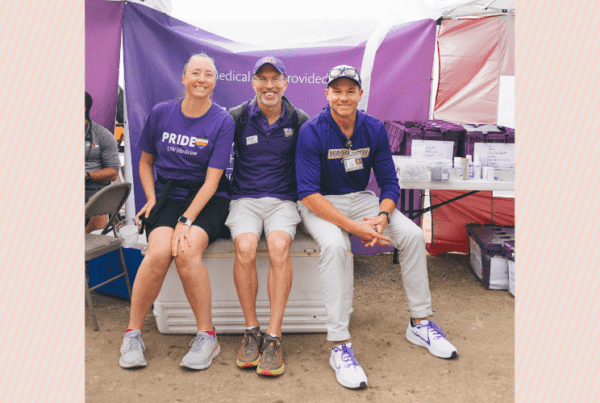HIGHLIGHTS | Creative Care
- Art and music therapy can help patients cope with and express what they are feeling.
- It can also help with pain management and physical therapy.
- Even small practices can reduce stress and promote well-being.
- Art and music can help everyone feel more connected.
It’s no question that art and music add vibrancy to life, but they also have the ability to help people heal.
At UW Medical Center – Montlake, the Arts in Healing program aims to do just that.
For the past several decades, the program has brought bedside and group art and music therapy to support patients in an array of ways, from providing pain relief after transplant surgery to aiding physical and speech therapy. The team even supports the hospital staff by providing creative therapies and self-care trainings.
Karen Neuhard-Forsythe, the program director; Gayle Cloud, a neurologic music therapist; and Amie Wicklund, an art therapist, share how incorporating art and music into your daily routine can help you and your patients be more resilient.
Find a creative outlet
Art and music can help build new neural pathways, which allows patients to process emotions that can be confusing or hard to express, Cloud says.
Neuhard-Forsythe and Wicklund use painting, drawing and coloring to help patients in rehab and oncology units relax and express themselves.
Similarly, singing, songwriting and lyric interpretation can help patients cope with their illnesses and feel more connected, which is particularly helpful for those who come from throughout the five-state region and do not have friends or family nearby.
Patients who feel stuck or frustrated can put those emotions into their lyrics, or they can draw what they find scary or confusing.
Either way, art and music help validate what patients are feeling by giving them a way to share their emotions.
Add small daily routines
Taking just a couple minutes each day to enjoy or practice art and music can make a big difference.
The Arts in Healing team helps patients include art and music in their everyday lives — and doctors and UW Medicine staff can benefit from these practices too.
Need some inspiration?
You can take online guitar or singing lessons, write a short story, watch recorded or livestreamed performances from your favorite artists or work on an adult coloring book.
If you’re crunched for time, carving out just five minutes to listen to a relaxing song or do a guided meditation can help lower your stress levels.
The Arts in Healing team also recommends checking out the artwork within the hospital.
“Both UW Medical Center – Montlake and Harborview have incredible, museum-caliber collections highlighting contemporary artists from the five-state region we serve,” Neuhard-Forsythe says. “It is a great distraction and opportunity to step away for just a couple of minutes to do something that feels normal.”
And if all else fails, one easy and helpful practice is to mark the end of your workday so that you don’t feel like you have to be on while you’re at home.
“Start a ritual that you can rely on each day at the end of your shift,” Wicklund says. “This could be starting an art journal, or maybe creating a magic wand that you wave over yourself as a way to transition from your role as a provider to your personal life at home.”
Create and connect during the coronavirus
In the time of the coronavirus, art and music can provide much needed connection, comfort and hope.
While patients currently have limited visitation to prevent the spread of disease, the Arts in Healing team is finding resourceful ways to connect, like online music therapy sessions or delivering art supplies and easy-to-follow instructions to patients.
Care team members and staff can utilize these resources too.
“Everyone needs some creative therapy to help with not only the stress of their day-to-day jobs, but to fill up their own wells during this difficult time,” Cloud says.
The Arts in Healing program sends out weekly emails that list free, virtual activities for patients and staff, with everything from opera performances to livestreamed concerts to authors and celebrities reading their favorite bedtime stories.
You can use creativity to connect with colleagues by submitting a 55-word story on your experience dealing with the coronavirus, or by doing something as simple as sending your favorite song to a coworker.
No matter how you choose to enjoy or express art and music, adding these small bursts of creativity throughout your day can help you cope with the unknown and ultimately bring you closer to your patients, coworkers and loved ones.


